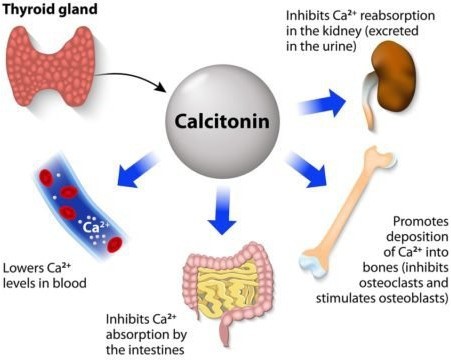The hormone that stimulates calcium deposition into bone is:
Calcitonin.
Parathyroid hormone.
Thyroxine.
Insulin.
The Correct Answer is A

Calcitonin is a hormone that protects against excessive blood calcium levels by inhibiting bone turnover and decreasing reabsorption.
It is produced by the thyroid gland and acts on both osteoclasts and osteoblasts.
Choice B is wrong because parathyroid hormone (PTH) stimulates both resorption and formation of bone, and controls the level of calcium in the blood.
Choice C is wrong because thyroxine is a thyroid hormone that is required for skeletal maturation and influences adult bone maintenance but does not directly affect calcium deposition into bone.
Choice D is wrong because insulin is a hormone that regulates both bone formation and bone resorption but does not specifically stimulate calcium deposition into bone.
Nursing Test Bank
Naxlex Comprehensive Predictor Exams
Related Questions
Correct Answer is B
Explanation
The correct answer is choice B. False.
Arteries are strong, elastic vessels that carry blood away from the heart, except for the coronary arteries that supply blood to the heart muscle.
These are the first arteries to branch off the aorta, which is the main artery that takes blood to the body from the left ventricle.
Choice A is wrong because it contradicts the definition of arteries. Arteries carry blood away from the heart, not to the heart.
Correct Answer is D
Explanation
A person who is stressed usually will have increased blood pressure because stress causes the body to release a surge of hormones that make the heart beat faster and the blood vessels narrow.
This can cause a temporary spike in blood pressure, which usually returns to normal once the stressor is gone.
Choice A is wrong because resistance to infections is not increased by stress.
In fact, chronic stress can weaken the immune system and make a person more prone to infections.
Choice B is wrong because the activity of the spleen and other lymphatic organs is not increased by stress.
The spleen and other lymphatic organs are part of the immune system, which can be affected by chronic stress in a negative way.
Choice C is wrong because the number of lymphocytes in the blood is not increased by stress. Lymphocytes are a type of white blood cell that help fight infections.
Chronic stress can reduce the number and function of lymphocytes and impair the immune response.
Whether you are a student looking to ace your exams or a practicing nurse seeking to enhance your expertise , our nursing education contents will empower you with the confidence and competence to make a difference in the lives of patients and become a respected leader in the healthcare field.
Visit Naxlex, invest in your future and unlock endless possibilities with our unparalleled nursing education contents today
Report Wrong Answer on the Current Question
Do you disagree with the answer? If yes, what is your expected answer? Explain.
Kindly be descriptive with the issue you are facing.
